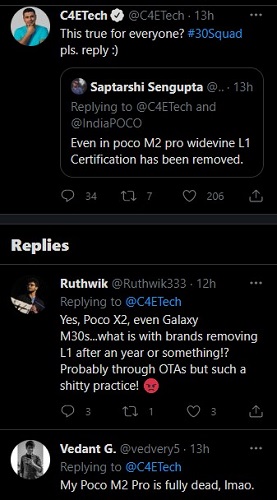Time for a #poll!
— PiunikaWeb - Everything Google Pixel (@PiunikaWeb) June 13, 2021
Do you think lack of regular support/timely updates and buggy software experience has turned many Android phones into 'smart burner phones'?
Vote below and read our opinion here: https://t.co/TdPDVhCjts#Android #smartphone #OpinionPoll
New updates are being added to the bottom of the story…
Original story (from June 13) follows:
Most people, yours truly among them, buy phones with the intention of keeping or using them for as long as possible. In fact, just about every modern phone is built to last.
However, sometimes people buy phones for short-term use. For instance, you can pick a cheap phone on your way to a protest rather than risk coming back home with a smashed Samsung Galaxy S21 Ultra later.
Regardless of what happens to this cheap phone, aptly dubbed “burner phone”, it won’t bother you. Because after all, it was never your intention to keep holding onto it after the protest.

You can easily pick up another unit without breaking the bank just in case it gets smashed or lost while at the protests. In fact, you don’t even expect anything from the OEM after purchasing the device.
But if your pricey smartphone got damaged, you’ll have to shell out some cash to get it fixed. If for some reason your OEM hasn’t sent software updates to your shiny flagship for a couple of months, it becomes a concern.
If you are still lost, burner phones are basically feature-less phones whose major purpose is to call and text. Heck, consider yourself lucky if you get a smart display that accepts touch input.
But again, if you are in the market for something basic and probably one to use for a few hours or days, this level of sophistication is unnecessary unless you really want to text a lot faster.

Well, sophistication is perhaps what everyone wants these days, which possibly explains the high figures in terms of smartphone sales. And Android vendors have mastered the art of catering to just about every pocket.
No doubt it’s great that everyone can own a smartphone depending on the much they can spend. All the way from $50 to beyond $1,000, Android has something for you.
Unfortunately, one of Android’s major strengths turns out to be a major issue when long-term use of phones comes into the fold.
Here’s the thing. Most first-time smartphone buyers coming from feature phones tend to be cautious with the much they spend on their handsets. More often than not, they end up with sub-$300 units.
Make no mistake, there are some great phones priced below $300, among them the Moto G Power/G Fast, Nokia 5.3, Samsung Galaxy A51, OnePlus Nord N10, Redmi Note 10 Pro Max, and even the Poco X3 Pro, just to mention a few.

These phones promise great battery life, quality display panels, good cameras, and are built from materials meant to last perhaps a few years, even when slightly roughed up.
To target the budget spenders, Android vendors, as noted earlier, have offerings below $100, among them the popular Moto E series, Samsung Galaxy A01, Nokia 1 family, and so on.
For a device that depends on software to execute daily tasks, there are bound to be bugs and issues popping up from time to time.
This is especially true since the installed apps get updated via the Google Play Store more regularly, and we know what new updates can at times do to performance of devices.
Unfortunately, most Android vendors tend to keep their focus on the high-end of the spectrum, leaving users of their budget phones stuck on old software that’s full of bugs and other performance issues.
The Motorola Moto E series of devices is a perfect example. Cheap they are, but you essentially are buying ‘smart burner phones’ since you won’t be getting any major Android OS upgrade.

Xiaomi’s Redmi line of devices is one of the most popular across the globe. But this isn’t enough to compel Xiaomi into taking software development more serious than they do.
Only one major Android OS upgrade is provided, and that too pretty late compared to their premium counterparts. Security updates are far apart, and even when they do arrive, they are accompanied by generic changelogs.
Realme started out well, but things have been deteriorating lately with slow and buggy updates becoming common. Perhaps they need to watch on the number of new devices they keep pumping into the market.
Oppo, Realme’s parent company, is doing a great job compared to a few years ago. Still, the pace at which software updates are released is wanting. Devices in the Oppo A series often get updates way later.
Vivo, another big company from China, also faces similar problems. Greyscale testing of updates is without a doubt a good thing, but it becomes annoying when the process often lasts ages.
If and when the updates do arrive, device owners are left with horror stories of bugs, errors, and performance glitches compared to previous versions.

As of this writing, none of Oppo, Realme, Vivo, Xiaomi, Motorola, Samsung or even OnePlus, the once fan favorite, is done with pushing Android 11 update to their phones.
The Nord series of devices from OnePlus, unlike their pricier counterparts, only get one major OS upgrade, yet no one doubts they are built to last a few more years in good hands.
For those still receiving multiple OxygenOS upgrades like OnePlus 7, 7T and even the slightly newer OnePlus 8T and OnePlus 9 series, there are plenty of bugs and issues to deal with.
When you are stuck with smartphones that no longer receive any software updates or rather attention from the OEM after just one or so years of use, well, they essentially become ‘smart burner phones’.
I know. You get what you pay for. This is the usual slap in the face you get whenever you make noise regarding slow or lack of updates on budget Android phones.
But what about the OG Asus ROG Phone that never got updated beyond Android Pie? Do you know the ROG Phone 2 cost $900 at launch yet it’s still stuck on Android 10 with no chances of getting Android 11?

Xiaomi was among the first to release a 5G-powered Xiaomi Mi MIX 3 5G phone. But to date, the device is stuck on Android Pie having received zero OS upgrades since launch. Same story with the Mi 9 Pro 5G.
On the flipside, the 2016 iPhone SE is set to bag the update to iOS 15 following its launch with iOS 9, yet it was priced at $399. And the fact that this update will arrive on the same day as the iPhone 12 Pro Max sums it all.
Android vendors need to stop and think about their customers. People buy these phones for different reasons, but what seems common is that most recent buyers intend to keep their units longer than before.
The good thing is that vendors are building quality phones to last, the bad thing is they are doing little to keep them in good working conditions in terms of software, more to the budget models.
This needs to end. After all, these are smartphones that depend on software to perform functions accordingly. They aren’t some smart burner phones despite their “affordable” price tags. And yeah, having outdated or buggy software isn’t helping them perform optimally.
Update 1 (June 06)
The results of the poll are out now.
While 59.3% believe the lack of regular support/timely updates and buggy software experience has turned many Android phones into ‘smart burner phones,’ 14.8% consider that’s the case with only a few.
7.4% are of the opinion that’s not the case while 18.5% aren’t aware of what exactly is a burner phone.
NOTE: The article will be updated after a week with results from the Twitter poll above.
PiunikaWeb started as purely an investigative tech journalism website with main focus on ‘breaking’ or ‘exclusive’ news. In no time, our stories got picked up by the likes of Forbes, Foxnews, Gizmodo, TechCrunch, Engadget, The Verge, Macrumors, and many others. Want to know more about us? Head here.

![[Poll results out] Android OEMs are practically selling 'smart burner phones' & here's why [Poll results out] Android OEMs are practically selling 'smart burner phones' & here's why](https://piunikaweb.com/wp-content/uploads/2021/06/Moto-E7.jpg)

